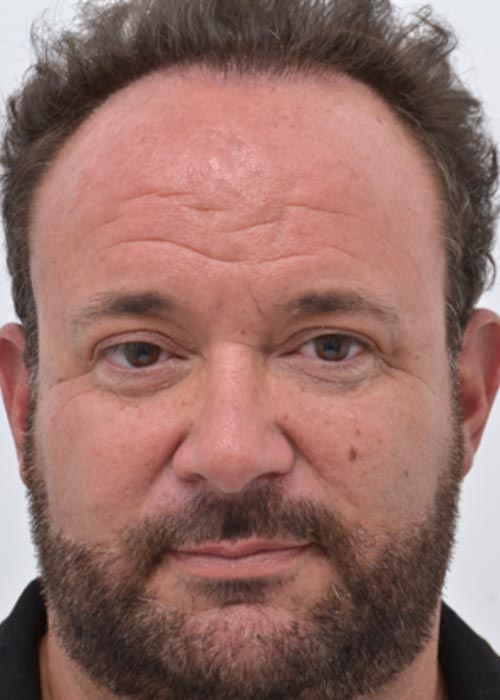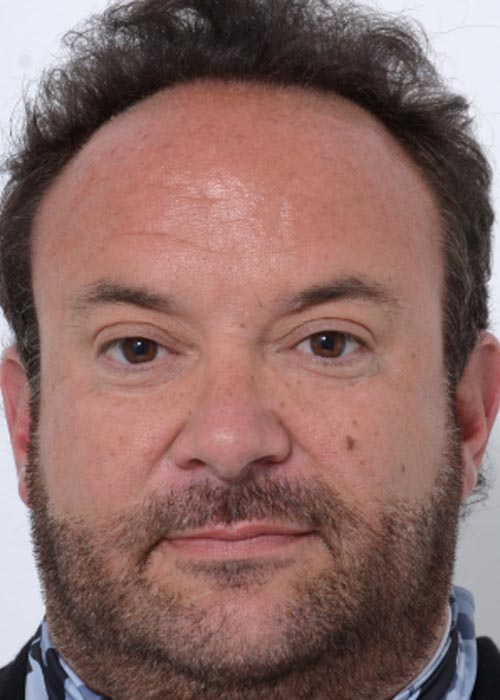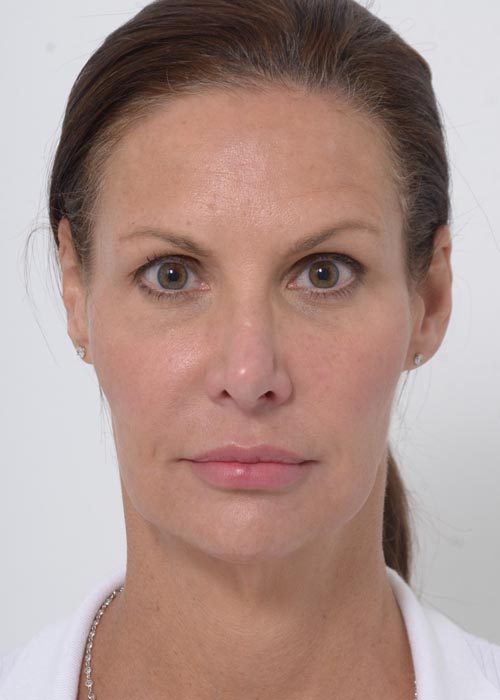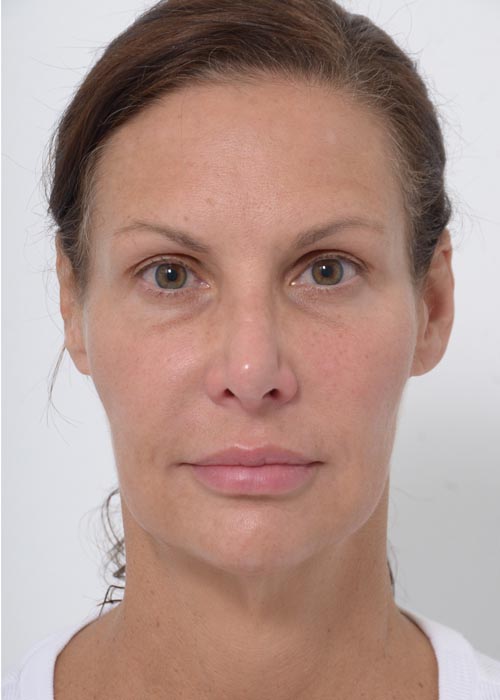Botox | Dysport
Botox® Cosmetic and Dysport® are both medicines that reduce unwanted lines and wrinkles in specific areas of the face by quieting the underlying muscle activity. In areas such as the forehead, glabella (area between the eyebrows), crows feet ( the area around the outer corner of the eye) and area around the mouth, the skin and underlying muscle connect so that when the muscle tightens, the skin overlying that specific muscle folds orthogonally to the direction of the muscle contracture. As skin loses elasticity, frequent folding of the skin will eventually leave a crease in the skin even when the muscle is at rest. To improve the lines in the above-mentioned areas, it is critical that the muscle activity be controlled. Botox® Cosmetic and Dysport® are chemically identical neuromodulator proteins that are manufactured to block the nerve endings release of the neurotransmitter acetylcholine so that the muscle can not contract . The beneficial effects of these medicines first appear about 2-3 days after injection, reach their maximum benefit by about day 10 and last on average between 3 and 5 months. To maintain the relaxation of the facial muscles that have been treated, retreatment is required. If the effects of the medication are allowed to go away completely, the muscles will simply return to their normal activity level unless the muscle has been kept asleep continuously for about 2 years or more. In that circumstance, the muscle may have atrophied to the point that some residual weakness may persist even if these medications are not continued. However, muscle atrophy cannot be reliably predicted.
Additional aesthetic uses for Botox® Cosmetic and Dysport® include balancing facial muscle activity in patients with facial paralysis, lifting of the eyebrows and corners of the mouth, opening the eyes in patients whose eyes become excessively squinted with smiling, controlling bunny lines on the nose, reducing the lateral fullness of a face by treating the masseter (chewing) muscles, reducing chin dimpling and dropping the upper lip to reduce excess maxillary (upper jaw) gum show.
Lastly, some of the most exciting news in neuromodulators is the growing body of research showing that Botox® Cosmetic and Dysport® not only relax muscle, they rejuvenate aging skin. A link has been established with Botox® Cosmetic and Dysport® injections and the prevention of free radical release by cells – essentially an antioxidant effect. These medications have been shown to also alter collagen and elastin in the skin, which not only makes the skin look less wrinkled but actually makes it appear younger at the same time.
Dr. Yellin is a nationally recognized expert in neuromodulators, which are medicines that temporarily reduce muscular activity. As an Allergan Trainer, he teaches other physicians throughout the country the proper techniques for using Botox® to enhance facial appearance.
Before & After Photos
*All photos shown are patients of Dr. Yellin and are the property of Marietta Facial Plastic Surgery, Laser & Aesthetics Center. Individual results may vary. Please see full disclaimer.






All photographs and other material presented on this website are the property of Dr. Yellin. Please do not download or reproduce the images without the express written consent of Dr. Yellin.
Disclaimer: Individual results may vary. No guarantee of results, stated or implied by any photo or statement on this website can be made. Please see full disclaimer.
Atlanta & Marietta Botox® Cosmetic and Dysport®
Established in 1996, Marietta Facial Plastic Surgery, Laser & Aesthetics Center is a premier destination for facial rejuvenation. We proudly offer Botox® Cosmetic and Dysport® to patients throughout Atlanta, Marietta, Woodstock, Acworth, and the rest of the country. To schedule a consultation or to request more information, please submit the form below or call us at (770) 425-7575.
FAQs
How do neuromodulators like Botox and Dysport soften fine lines?
They interrupt the signal between facial nerves and the tiny muscles that crease skin when you frown, squint, or raise your brows. With those muscles temporarily relaxed, the overlying skin lies flat instead of folding into wrinkles. Existing lines look smoother, and skin is spared the repetitive compression that deepens creases over time. Treated areas still feel normal; only the targeted contraction strength is dialed down.
Which facial areas respond best to Botox and Dysport?
Dynamic expression zones—forehead horizontal lines, glabellar “11s” between the brows, and crow’s-feet at the eye corners—usually show the most visible improvement because their wrinkles stem directly from muscle pull. Subtler benefits appear in bunny lines on the nose, a gentle lip flip, and a pebble-textured chin, all while leaving untreated areas fully expressive.
What is the difference between Botox and Dysport in formulation?
Both contain purified botulinum type A protein but use distinct accessory proteins and dilution systems. These background ingredients influence how widely the product diffuses and how many units achieve a given effect. Your injector selects the brand that best suits muscle size, desired spread, and personal response history to ensure smooth, consistent results.
Who makes a good candidate for Botox and Dysport?
Anyone bothered by movement-related lines, who is in good overall health, not pregnant or nursing, and free from certain neuromuscular disorders can typically proceed. Ideal candidates prefer a quick, office-based option and understand the result is gradual and temporary. A thorough consultation reviews medical history, past injectables, and desired subtlety.
Can Botox and Dysport help prevent new wrinkles from forming?
Yes. By limiting the repetitive folding that etches lines, neuromodulators act like a wrinkle “pause button.” Consistent, moderate dosing trains muscles to relax more readily, so skin ages at a slower pace in treated areas. Preventive use targets early, shallow creases before they dig in permanently.
How does muscle activity relate to expression lines?
Every frown, squint, or eyebrow raise bunches skin into predictable folds. Over years, collagen in those folds thins, and the temporary line stays visible even at rest. Targeted neuromodulators ease the muscle’s pull, allowing collagen to rebound and the crease to relax—treating the mechanical cause rather than merely masking surface lines.
Will my face look frozen after Botox and Dysport treatment?
A skilled injector doses only the fibers responsible for unwanted creases, leaving neighboring strands free to convey emotion. You can still smile, frown, and raise your brows—just without the deep furrow or crinkling that previously accompanied those moves. Results aim for “well-rested,” not “expressionless.”
How are Botox and Dysport doses customized for men versus women?
Male facial muscles are generally thicker and need slightly more product for equal softening, while many women require lighter units to avoid over-relaxation. Your provider has you animate—frown, squint, smile—then tailors unit counts and injection points so the effect matches both muscle strength and aesthetic goals.
Can Botox or Dysport create a subtle brow lift?
Yes. Relaxing the downward-pulling brow depressor fibers lets the natural elevating frontalis work unopposed, nudging the brow tail slightly upward. This opens the eye area and reduces lid heaviness without surgery or added volume, provided placement is precise.
Is any special preparation needed before an appointment?
Arrive with a clean face. Minimizing alcohol, high-dose fish oil, or non-essential blood-thinning supplements for a few days may lessen pinpoint bruising. Your provider will also review medications, recent vaccinations, or planned dental work to time treatment safely within your overall schedule.
How does treating the masseter muscle slim the jawline?
If the chewing muscle is bulky from clenching or genetics, neuromodulator injections reduce its contracting power. Over a few months the muscle remodels, softening square jaw angles into a slimmer V-shape while often easing tension or night-time grinding. Normal chewing remains intact.
Do Botox and Dysport pair well with dermal fillers?
Yes. They tackle different aging factors—muscle movement versus volume loss—so combining them often yields the most balanced rejuvenation. Relaxing over-active muscles first can even prolong filler smoothness by reducing fold pressure, resulting in a comprehensive yet natural refresh.
How is natural facial expression preserved?
The injector identifies minimal doses that soften lines but keep essential muscles functional. Serial treatments build familiarity with your responsiveness, allowing precise maintenance rather than blanket dosing. You still raise eyebrows in surprise or laugh freely—just without deep creasing that once lingered.
Can neuromodulators help with teeth grinding or tension headaches?
When clenching stems from over-active jaw muscles, targeted relaxation lessens bite force and associated strain, reducing wear on teeth and easing related head or neck discomfort. The goal is gentle weakening, not paralysis, so daily chewing and speaking remain comfortable.
What factors influence when someone repeats treatment?
Duration varies with muscle strength and how quickly nerve endings rebuild. Many people return at three to four months when expression feels strong again. Regular check-ins help set a rhythm that maintains smoothness without over-treating.
Is the procedure reversible if I dislike the result?
Neuromodulators wear off naturally as nerve signals regenerate, so any over-softening fades. While there’s no instant reversal like dissolving filler, future sessions can adjust dose or placement to achieve your preferred balance.
What myths about Botox and Dysport deserve clarification?
They don’t accumulate in the body; the protein acts locally and breaks down into harmless peptides. Nor do they create dependence—stopping simply lets muscles return to baseline without worsening wrinkles. Finally, properly dosed treatment should leave you expressive, not frozen.
